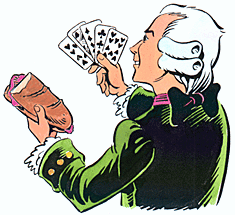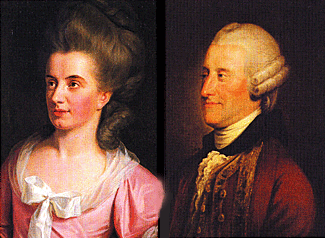Sandwich, the Origin, Part 1 of 2
(Where did the word “sandwich” really come from?)
The Sandwich—a Word with Nefarious, Blasphemous, and Corrupt Origins?
The sandwich, which is most popular with world-wide eaters, functions as a noun or a verb and usually prefers to have its name pronounced as SAND wich. Besides the more obvious occupation of being something edible between two or more slices of bread, metaphorically speaking, it also likes to squeeze in between two other people, places, things, materials, etc.; as, he is willing to sandwich an appointment in between two other meetings or her car was sandwiched between two other cars in the parking lot.
The most popular perspective regarding the origin of the word sandwich, which we use today, is that it was born in London during the very late hours one night in 1762 when an English nobleman, John Montagu, the Fourth Earl of Sandwich (1718-1792), was too busy gambling to stop for a meal even though he was hungry for some food.
The legend goes that he ordered a waiter to bring him roast-beef between two slices of bread. The Earl was able to continue his gambling while eating his snack; and from that incident, we have inherited that quick-food product that we now know as the sandwich.
The Earl apparently had the meat put on slices of bread so he wouldn’t get his fingers greasy while he was playing cards. It’s strange that the name of this "sex fiend" should have gone down in history connected to such an innocent article of diet.

The Earl of Sandwich, the sandwich, and the town of Sandwich
The title, Earl of Sandwich, comes from Old English (O.E.) Sandwic, and literally means “sand village”, “Sandy Place”, or “Place on the Sand”. The old English wic is a loan word from Latin vicus, “hamlet”, which also gives us the word vicinity. The first recorded mention of the town was around 640 A.D.
According to Sue Fielder in her Open Sandwich site (reproduced here with her permission):
Hereditary English titles can be confusing. The family of the Earls of Sandwich has no real connection to the town itself, only the title. Apparently, the First Earl, Edward Montagu, originally intended to take the title of the Earl of Portsmouth—this might have been changed to honor the town of Sandwich, because the fleet he was commanding in 1660 was lying off the coast of Sandwich, before it sailed to bring Charles II back to England.
It is generally thought that neither the town of Sandwich, nor the word “sandwich” as an item of food, has any reference to each other, only with John Montagu, who happened to have the title. A sandwich could just as easily have been called a “portsmouth” if the First Earl, Edward Montagu, had not changed his mind.
Imagine ordering a “hamburger portsmouth, please” or a “bacon and egg portsmouth”. Well, why not? [J.R.]
The Fourth Earl of Sandwich was considered one of the most immoral men of his time.
John Montagu is said to have been immoral in both his private and public life, and gambling was just one of his lesser vices. He was the First Lord of the Admiralty, incompetent and very corrupt. In fact, it is very likely that he indirectly contributed to the success of the American Revolution because of his malfeasance as the chief admiral of the English navy.
According to Jane Polley, “Sandwich managed to reduce the British Navy to a state of total confusion around the time that the American Revolution started—a contribution at least as significant as the munchable lunch.”
The Earl was a member of a group of Satan Worshippers called “The Friars of St. Francis of Wycombe”, also known as “The Hell Fire Club”. He boasted that he specialized in seducing virgins because he enjoyed “the corruption of innocence, for its own sake.”
Sandwich was the executive officer of the Club and was described as being “as mischievous as a monkey and as lecherous as a goat.” He was also called “the most universally disliked man in England.”
According to Daniel Mannix in his The Hell Fire Club, “In addition to being anti-religious, Sandwich was violently anti-democratic. He despised the general public and opposed any public figure who tried to get a better break for the common man. Because of his friendship with the King and his control of the English Navy, Sandwich was one of the most important men of the time and exerted a profound influence on the destiny of the British Empire.”
There is still another view as to where the Earl of Sandwich applied his eating style

An article in the May, 2005, issue of the Smithsonian magazine titled: "Fatal Triangle" by John Brewer makes the following statements:
- Unseasonable heat and humidity on the evening of April 7, 1779, did not stop Londoners' usual pursuit of business and pleasure.
- Over in Whitehall, the first lord of the admiralty, the Earl of Sandwich, discussed with his harried colleagues the prosecution of the American war.
- A key strategist in bringing the 13 colonies to heel, Sandwich was a tall, rather clumsy man in his 60s known as a libertine, a passionate fan of the sport of cricket and a great patron of music, especially the work of George Frideric Handel.
- He was also a hardworking and ruthless politician.
- The snack that bears Sandwich's name, which was first made by slipping a slice of salted beef between two pieces of bread, was invented not, as legend would have it, to allow the earl longer hours at the gaming table but more time at the office. [Now is this another "legend"? There was no further information in this article that would validate Brewer's allegation regarding the "legend" versus the earl's desire to spend "more time at the office." In addition to the earl's other manias, was he also an ergomaniac? J.R.]
- On this particular evening Sandwich's late-night labors, although he had originally planned to go to the theater, were prompted by a pressing threat to his political career.
- The war in America was going badly, George III's administration was in disarray, and it looked as if Sandwich might be sacrificed to appease government critics.
- Martha Ray was Sandwich's 35-year-old mistress. Ray, the daughter of a corset maker, had been a milliner's apprentice before falling in with the earl.
- At this time, she had been Sandwich's mistress for more than sixteen years, the mother of five of his six children, and his public consort.
- Her height was about five feet five inches; she was described as having "a perpetual smile on her countenance, which rendered her agreeable to every beholder."
It was on this particular evening that Martha Ray was shot in the head, as she was attempting to get into her carriage after seeing a theatrical performance, when James Hackman "pulled two pistols from his pockets, shot Ray with the one in his right hand, and shot himself with the other." According to author and gossip Horace Walpole, Hackman "came round behind [Ray], pulled her by the gown, and on her turning round, clapped the pisol to her forehead and shot her through the head. With another pistol he then attempted to shoot himself, but the ball grazing his brow, he tried to dash out his own brains with the pistol, and is more wounded by those blows than by the ball." Hackman writhed on the ground, "beating himself about the head . . . crying, 'o! kill me! . . . for God's sake kill me!"
Apparently James Hackman had been in love with Martha Ray for some time before this killing took place and he was believed to be considerably upset when he saw Ray being touched by another man who was helping her through a crowd and into her carriage. He had first planned to just kill himself, but his emotional distress was so utterly overwhelming that he completely lost control of rational judgement.
